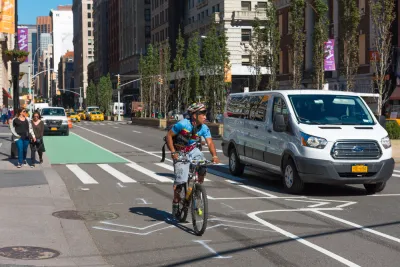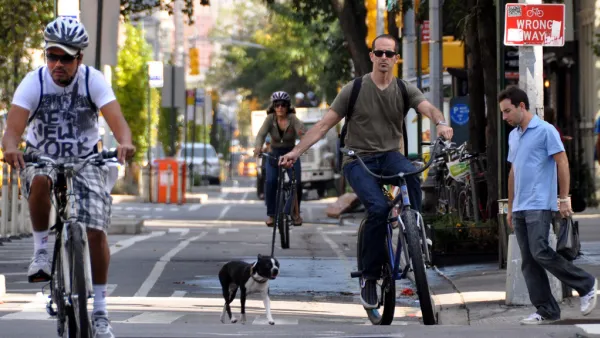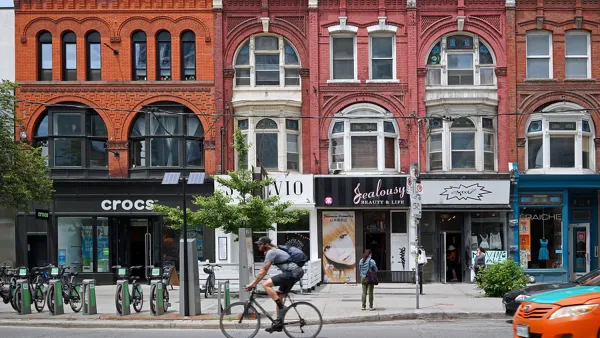Could the pandemic be a tipping point for a century of car-centric planning in New York City's to give way to a more bike-friendly city?

New York Times architecture critic Michael Kimmelman surveys the changing politics of bike planning in New York City, as evidenced by a slew of innovations implemented as public health and economic stimulus actions during the pandemic. Kimmelman starts off by describing recent planning developments, all documented previously Planetizen, as a glimmer of hope for a change to planning in the city.
- 'Open Restaurants on Open Streets' Program Announced in NYC (July 6, 2020)
- Electric Bikes and Scooters Legalized in New York City (June 29, 2020)
- First New Bridge to Manhattan in Decades Proposed Just for Pedestrians and People on Bikes (June 25, 2020)
- Bike-Centered Brooklyn Bridge Redo Under Consideration (June 22, 2020)
- Five Borough Bikeway Plan Released (June 18, 2020)
- Court Decision Clears the Way for East River Greenway Bike Bridge (May 12, 2020)
- Signal Priority in N.Y.C. to Make Streets Safer for Cyclists (November 6, 2019)
According to Kimmelman, the city is faced with two particularly ambitious potential paths forward to ensure a more bike-friendly future: the Regional Plan Association's Five Borough Bikeway Plan and the Queens Ribbon Bridge. The time is now to act on plans like these, argues Kimmelman:
Getting through this whole crisis depends on city leaders’ capacity to think ahead, not hunker down. Robert Moses, New York’s storied planning czar, plotted during the depths of the Depression so he could be ready when the money materialized. Whatever else one might say about Moses, he knew how to get stuff done.
By contrast, New York today has become good at shooting down new ideas, celebrating defeat over compromise, pointing out why any big, costly initiative is not worth pursuing because something else also needs doing, as if a great city shouldn’t find ways to do more than one thing at a time.
The city has changed before, according to one of the big statements included in this article. The current economic and public health crisis could provide another tipping point.
FULL STORY: New York as a Biking City? It Could Happen. And It Should.

National Parks Layoffs Will Cause Communities to Lose Billions
Thousands of essential park workers were laid off this week, just before the busy spring break season.

Retro-silient?: America’s First “Eco-burb,” The Woodlands Turns 50
A master-planned community north of Houston offers lessons on green infrastructure and resilient design, but falls short of its founder’s lofty affordability and walkability goals.

Delivering for America Plan Will Downgrade Mail Service in at Least 49.5 Percent of Zip Codes
Republican and Democrat lawmakers criticize the plan for its disproportionate negative impact on rural communities.

Test News Post 1
This is a summary

Test News Headline 46
Test for the image on the front page.

Balancing Bombs and Butterflies: How the National Guard Protects a Rare Species
The National Guard at Fort Indiantown Gap uses GIS technology and land management strategies to balance military training with conservation efforts, ensuring the survival of the rare eastern regal fritillary butterfly.
Urban Design for Planners 1: Software Tools
This six-course series explores essential urban design concepts using open source software and equips planners with the tools they need to participate fully in the urban design process.
Planning for Universal Design
Learn the tools for implementing Universal Design in planning regulations.
EMC Planning Group, Inc.
Planetizen
Planetizen
Mpact (formerly Rail~Volution)
Great Falls Development Authority, Inc.
HUDs Office of Policy Development and Research
NYU Wagner Graduate School of Public Service





























